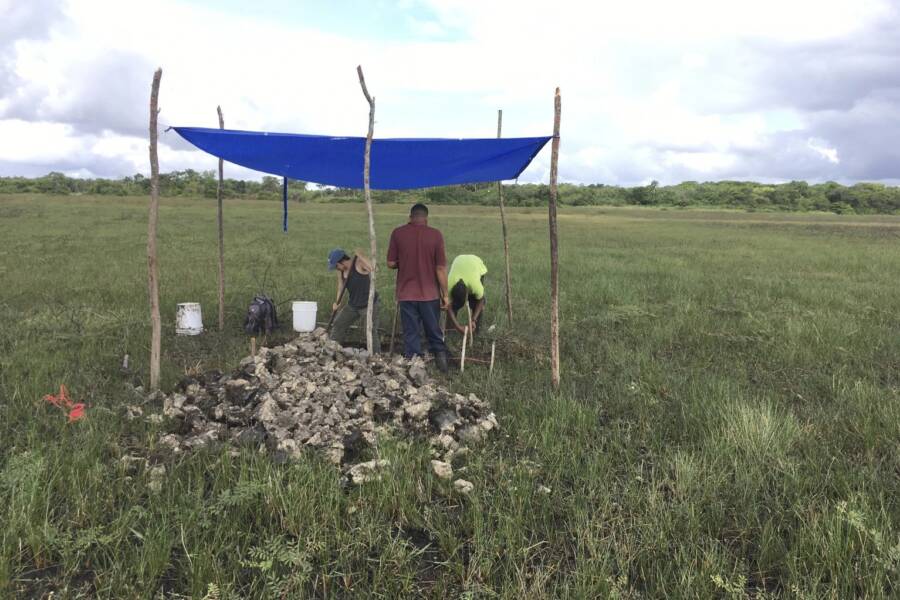Researchers have long theorized that agriculture was the main stepping stone toward civilization in ancient Mesoamerica — but this recent discovery in Belize might rewrite that history.

Belize River East Archaeology Archaeologists work to excavate sediment in order to date the pre-Maya canals discovered in Belize.
Before the Maya built their now-iconic pyramids, their predecessors built a network of canals in the wetlands of present-day Belize. And though the latter may not sound as impressive as the former, these waterways might have had a profound impact on the march toward civilization in the region.
Meant to trap fish, these canals were long hidden by the natural landscape of Crooked Tree Wildlife Sanctuary. But with the help of drones and Google Earth, a team of archaeologists have recently been able to uncover them.
These fishing canals both speak to the industriousness of pre-Maya peoples, and show how they laid some of the foundation for civilization to flourish in ancient Mesoamerica.
Discovering The Pre-Maya Fishing Canals In Belize

Belize River East Archaeology ProjectProbable fish-trapping sites identified across the pre-Maya lowlands.
According to a new study published in Science Advances, the archaeologists focused their attention on Crooked Tree Wildlife Sanctuary (CTWS), which is the largest inland wetland in Belize. Using aerial imaging technology, they were able to identify canals built by pre-Maya people some 4,000 years ago.
“Here and in several other locations in the Maya Lowlands, our team has identified through remote sensing (using drones and Google Earth imagery) a vast network of linear earthen channels or weirs,” the study authors wrote. “These linear features closely resemble other pre-Columbian fish-trapping facilities recorded in similar tropical environments of the Bolivian Amazon as well as ethnographic examples found in Zambia, Africa.”
These canals were built by pre-Maya people to catch freshwater fish (indeed, archaeologists found “barbed points” at the sites that are suggestive of spearfishing) and were in use for around 1,000 years.
And though the canals pre-date the Maya — who emerged around 2000 B.C.E. and first built cities some 1,250 years after that — they may have laid some of the foundation that allowed Maya civilization to flourish.
What These Canals Might Reveal About The Development Of Civilization In Ancient Mesoamerica

PhilippN/Wikimedia CommonsThe ancient Maya are best known for the stunning archaeological sites they left behind, which include impressive pyramids like this one in Calakmul.
The canals, which may have originally been dug in response to “long-term climate disturbance recorded between 2200 and 1900 BCE,” were used by pre-Maya people and their descendants. After being constructed by hunter-gatherer-fishers, the study suggests that the canals continued to be used by the ancient Maya between 2000 B.C.E. and 200 C.E.
Aside from their practical use, the canals also may have provided some of the groundwork for Maya civilization to grow. They demonstrate how pre-Maya people developed the landscape around them to suit their needs, something that their descendants would do as well when they created roads, temples, and pyramids. And the canals provided a diversified diet (fish alongside staples like maize) that would have fueled the growth of civilization by providing enough of a stable food source to allow transition from a nomadic lifestyle to one in which settlements could arise.
“Agricultural intensification after 2000 B.C.E. has been credited for supporting the rise of pre-Columbian civilizations in Formative Mesoamerica,” the study’s authors explained, “but we suggest that some groups relied more heavily on the mass harvesting of aquatic resources. We argue that such early intensification of aquatic food production offered a high value subsistence strategy that was instrumental in the emergence of Formative period sedentarism and the development of complexity among pre-Columbian civilizations like the Maya.”
As such, this network of 4,000-year-old canals — quietly nestled into the natural landscape of Belize — might reveal a great deal about the development of the Maya civilization. The hunter-gatherer-fishers who built them had the ingenuity and imagination to harness the world around them. Their Maya descendants, perhaps endowed with a similar world outlook, then took it one step further when they constructed pyramids reaching toward the heavens.
After reading about the 4,000-year-old canals discovered in Belize that pre-Maya people used to trap fish, discover the story of Camazotz, the terrifying “death bat” of ancient Maya myth. Then, learn about El Castillo, the towering ancient Maya pyramid of Chichén Itzá.





